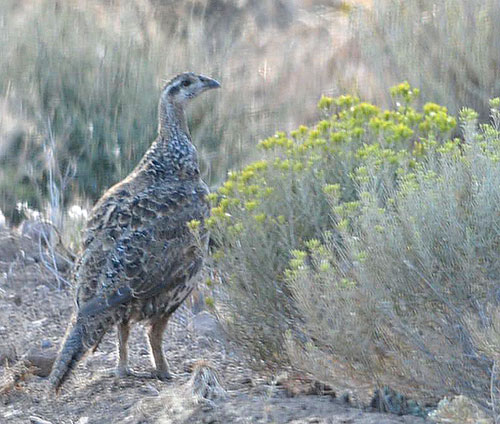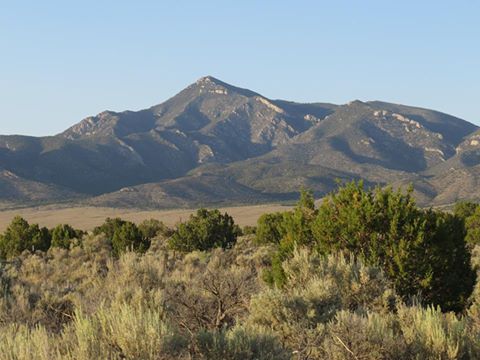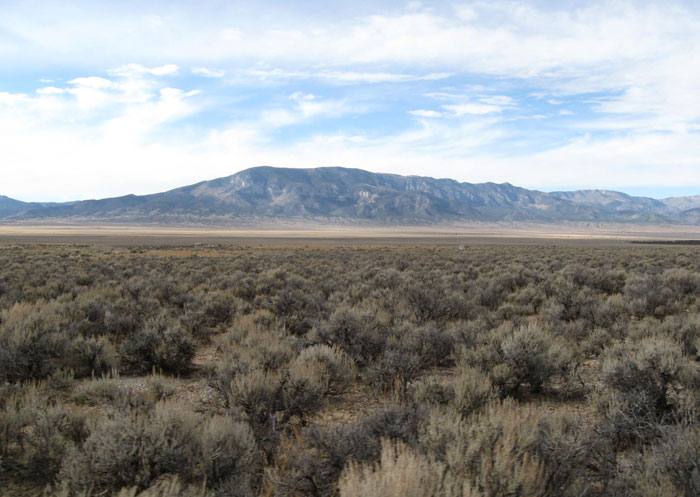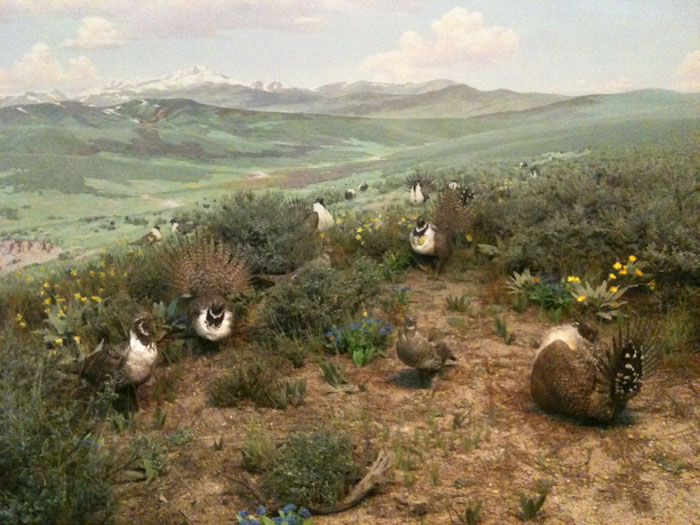Streamlining an Already Questionable Sage Grouse Conservation Initiative?

^A controversial bird, Greater sage grouse hen at Hart Mountain, Oregon.
November 25, 2017 - We have been contemplating how to comment on the report titled "Greater Sage-Grouse Conservation and Cooperation with Western States" put out by the Department of Interior under Secretary Ryan Zinke, apparently put out in response to Western states' feedback to the complex federal-state-private set of agreements set under Interior Secretary Sally Jewell in 2015.
And this was in response to the decision by US Fish and Wildlife Service in 2010 that the Greater sage grouse (Centrocercus urophasianus) warranted protection under the Endangered Species Act, but that listing was precluded because of a backlog of "higher priority species" (see https://www.endangeredspecieslawandpolicy.com/2010/03/articles/fish-wildlife-service/greater-sage-grouse-listing-warranted-but-precluded/).
The Service admitted that such factors as habitat fragmentation, energy development, and grazing were part of the problem causing a drop in populations of sage grouse. Yet they forged ahead to work with private landowners to conserve the candidate species. This would include financial and technical assistance, and the ability to develop conservation agreements among various federal agencies to provide regulatory assurances to landowners who take actions to benefit the species, including cattle ranchers, mining companies, and fossil fuel drillers. Thus the Sage Grouse Initiative was born (subtitled "Wildlife Conservation Through Sustainable Ranching"), as well as individual state initiatives that attempt to conserve the grouse but also continue economic development in its habitat.
An unsustainable deal for the species? The exact nature of the conservation agreements, and whether they actually work or not, is a main question we have.
Because most sage grouse habitat is on Bureau of Land Management (BLM) land, the burden falls on the Department of Interior to manage the bird in a "cooperative way" that would continue to keep the species off the Endangered Species Act list. But is this a politically motivated goal or a scientifically supported one?
Grazing
The issue is highly complex, and we do not attempt to answer the many questions here. For instance, bison, elk, mule deer, and pronghorn antelope are native to many parts of the sagebrush ecosystems across Western North America, and bison in particular have been much reduced in numbers and geographic range. Small herds of bison roamed across the grassier parts of the northern Great Basin Sagebrush ecosystems before European Contact. So perhaps forms of sustainable ranching can mimic prehistoric grazing ecosystems in appropriate habitats. But this needs much more study and independent scientific support before blanket prescriptions can be made that "grazing is good for sage grouse." Control sites should be set up that exclude grazing to be able to compare sage grouse counts to areas where grazing occurs in sage grouse habitat.
Pinyon-Juniper Habitats and Sagebrush

^Utah junipers and big sagebrush in the White River Valley, with the Egan Range in eastern Nevada. Greater sage grouse Priority Habitat Management Area and General Habitat Management Area.
Many sage grouse habitat "restoration" management actions recommended by agencies to ranchers include pinyon-juniper woodland "treatments" that involve controversial destruction of biologically diverse native woodland and savanna habitats that interfinger and merge with sagebrush habitats in complex ways. Sage grouse use open pinyon-juniper woodlands, and we have seen them in such habitats commonly in the Great Basin. Generalized prescriptions to clear away such native woodlands to "improve" sage grouse habitat are not supported in our opinion, and may lead to the use of such "treatments" as an easy was for private land owners to gain "credits" for false conservation measures which are not shown to actually increase sage grouse populations.
In addition, federal and state agencies may use such pinyon-juniper "fuel treatment" projects as a way to check off management goals that claim to restore sage grouse habitats, when in actuality wildfires may benefit sage grouse by creating a patch mosaic of seral stages of grass-sagebrush-pinyon-juniper communities that has been occurring with lightning strikes since prehistoric times. This also needs much more study, especially in the realm of historical ecological research.
Vegetation scientists define Pinyon Pine (Pinus monophylla) Woodland Alliance in the western edge of the Great basin in transmontane California, as having greater than 5% pinyon pine tree canopy. This means a pinyon pine woodland may have a very open ground cover, easily including sagebrush and grass. Co-dominants include Utah juniper (Juniperus osteosperma), big sagebrush (Artemisia tridentata), little sagebrush (A. arbuscula), and black sagebrush (A. nova)(Sawyer et al. 2009).
Greater sage grouse overlap with this vegetation community well according to various studies: Aldridge et al. (2008) found long-term sage grouse persistence required a minimum of 25% sagebrush cover at the 30-km scale, and preferably 65%. That means open pinyon-juniper woodland, or even a smaller percent of dense woodland can be present and apparently not negatively impact sage grouse. Knick et al. (2013) found that 90% of active leks in the western part of the sage grouse range had more than 40% sagebrush cover within 5 km of leks. This can mean that 60% of the landscape could have pinyon-juniper woodland in some form of cover and sage grouse are present. Wisdom et al. (2011) found that sage grouse had a high probability or persistence with greater than 50% sagebrush cover within 18 km of leks, and a high risk of extirpation with less than 27% sagebrush cover. Yet all these studies found that a 100% sagebrush cover was not required for sage grouse persistence--a mixed landscape as is typically found in the Intermontane West with a mosaic of open sagebrush, grassy patches, old wildfire burn scars regrowing through successional communities, as well as open to closed pinyon-juniper woodland is just what Greater sage grouse are adapted to. A mixed vegetation including grass, shrubs, and trees, not a pure sagebrush landscape necessarily. Much more research should be done about how sage grouse interact with the landscape and vegetation cover.
The recent over-reliance on computer modeling is no replacement for field studies of greater significance such as woodrat midden analysis, pollen analysis of ponds and lakes, tree ring studies, review of historical descriptions, and Traditional Ecological Knowledge of Native Tribal people.
Commenting on the Notice of Intent to Amend Greater sage grouse Resource Management Plan Revisions and Amendments
On June 7, 2017, Secretary of the Interior Ryan Zinke signed Secretarial Order 3353, “Greater Sage-Grouse Conservation and Cooperation with Western States.” According to the Bureau of Land Management website, the Order’s aim is to "improve sage grouse conservation by strengthening communication and collaboration between states and the federal government, with the shared goal of conserving and protecting sage grouse and its habitat while also ensuring that conservation efforts do not impede local economic opportunities."
In an effort to standardize the sage grouse management policies across states, as well as streamline energy development, the order goes on to say, "A Department of the Interior (DOI) Review Team with staff support from the BLM, USGS, USFWS and USFS worked with representatives of Western states – through the Western Governors' Association Sage Grouse Task Force – to develop a suite of recommendations for revisions to procedures, policies and management plans for sage grouse conservation, with preliminary indications of whether they could be implemented through clarification, policy, or training, or whether potential plan amendment processes should be considered."
The comment deadline is December 1, 2017, and comments may be sent here. Although the Secretary seems to prefer comments from the various Western states on how to prevent the sage grouse from hindering future economic development and oil and gas exploration. But to be fair, under the last administration, the same policies were written to allow economic growth and energy development to occur in sage grouse habitat, with "stipulations," "waivers," and mitigation. Zinke seeks to streamline these policies and clarify them across states. This is not a good trend, but is this built on a poor foundation to begin with?
We have seen parallels to this opening of the developer's Pandora's Box and subsequent streamlining with renewable energy development in the Southwest Desert under the Solar Programmatic Environmental Impact Statement, and Desert Renewable Energy Conservation Plan in California. We do not think that market forces can reliably conserve declining species.
Once economic development becomes the goal and driver of land management policy, conservation always takes a back seat.

^Sagebrush Sea in Spring Valley, eastern Nevada. After this photo was taken the valley was developed by a wind energy company, despite the presence of Greater sage grouse leks, with a set of mitigation measures. Oil and gas drilling will be no different.

^The way it used to be: sagebrush hills and basins crowded with noisy sage grouse males displaying during the spring. A Greater sage grouse lek scene in a museum, diorama.
A few Comments on the DOI Report in Response to Secretarial Order 3353, August 4, 2017:
We oppose simply repealing the Greater Sage Grouse Sagebrush Focal Areas (SFAs): keep the SFAs as a starting point, but in the future offer alternatives in an Environmental Impact Statement to add, reduce, or change boundaries with full public participation.
We oppose captive breeding and predator control as options for sage grouse management. We need to conserve large areas of intact and undisturbed habitat as the main action to protect sage grouse populations.
We do recommend using the most up-to-date scientific methods to count sage grouse numbers in order to track population trends.
In the DOI Sage Grouse recommendations paper, Appendix A, page 2, there is one short-term option to deal with rising disturbance in areas with caps (perhaps due to increased oil and gas exploration) in the chart that says: “In cooperation with the State, investigate opportunity to accelerate restoration and recovery efforts in areas in which the caps are being approached.”
This could lead to an increase in clearing of native pinyon-juniper woodlands in management efforts that are often described in the recent sagebrush ecosystem literature as “restoring sagebrush habitats for Greater sage grouse.” In this scenario we could see oil and gas drillers buying credits through misguided pinyon-juniper woodland “treatments” in order to increase their ground-disturbance activities. In this case the result would be both disturbed pinyon-juniper woodlands and savannas, and disturbed sagebrush scrub. To us this does not meet the goals of a “Net Conservation Gain.”
There is a continual trend towards less on-the-ground habitat assessment, and more “streamlined” approaches, such as remote sensing. But these miss valuable habitat characters such as native grasses present in the understory of Class III pinyon-juniper woodland, as well as the abundance of biological soil crusts. It also ignores the population levels of species such as pinyon jays and various chipmunks that use pinyon-juniper habitats.
Appendix A, page 7: States ask for clarification and standardization of habitat objectives and the importance of the current ecological state of the monitoring site. This indicates a lot of uncertainty is already present in the science, and new input can change interpretations. More independent scientific studies should be undertaken to clarify the ecological relations of sage grouse to grazing, to different habitats, including sagebrush and pinyon-juniper woodlands, as well as sage grouse relations to fire ecology in the Great Basin.
Appendix B, page 1: DOI recommends increasing the use of biopesticides and herbicides, as well as EPA’s time to approve new chemicals, in order to treat weeds on burns. We strongly disapprove of adding more chemicals to natural ecosystems in the Sagebrush Sea. Let wildfire burns recover naturally, less ground disturbance can move cheatgrass habitats towards native grass, forb, and shrub communities over time. But not necessarily with cattle grazing.
Building on an Unstable Base
After reviewing the Sage Grouse Initiative, the northeastern California-Nevada BLM land use plan amendment and state Conservation Credit System, and Department of Interior's report on possible changes--all want to graze, frack, drill, mine and cut down pinyon pines and junipers on grouse habitat. This appears to us as a lose-lose situation for the sage grouse and a win for cattle ranchers and developers.
All versions are too reliant on market mechanisms to continue the mutually exclusive goals of economic growth while somehow also preventing the fragmentation of large undisturbed chunks of sage grouse habitat. The 2015 version under Sally Jewell opens up the allowance of oil and gas drilling in sage grouse habitat, as well as using cattle grazing as a “conservation” management method to maintain or improve sage grouse habitat. The Zinke recommendations merely widen and streamline those economic endeavors. Both versions of the cooperative management policy may be heading in the wrong direction, and not ecologically based.
References
Aldridge, C. L., Nielsen, S. E., Beyer, H. L., Boyce, M. S., Connelly, J.
W., Knick, S. T, Schroeder, M. A. 2008. Range-wide patterns of greater sage-grouse persistence. Diversity and Distributions 14:983–994.
Knick, S. T., Hanser, S. E., Preston, K. L. 2013. Modeling ecological minimum requirements for distribution of greater sage-grouse leks: Implications for population connectivity across their western range, U.S.A. Ecology and Evolution 3(6):1539–1551.
Sawyer, J.O., T. Keeler-Wolf, and J.M. Evens. 2009. A Manual of California Vegetation, Second Edition. California Native Plant Society and California Department of Fish and Wildlife: Sacramento CA.
Wisdom, M. J, Meinke, C. W, Knick, S. T., Schroeder, M. A. 2011. Factors associated with extirpation of sage-grouse. In: Knick, S. T, Connelly, J. W., eds. Greater sage-Grouse: Ecology and conservation of a landscape species and its habitats. Studies in Avian Biology 38. Berkeley, CA: University of California Press: 451-474.
